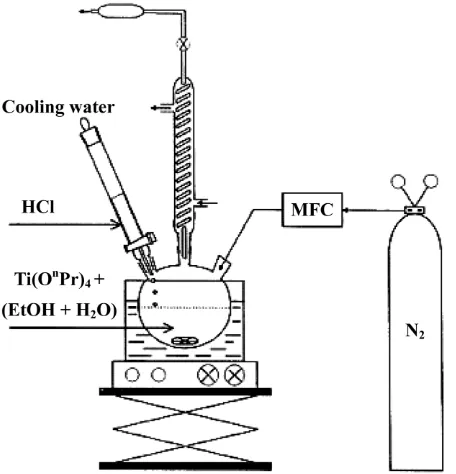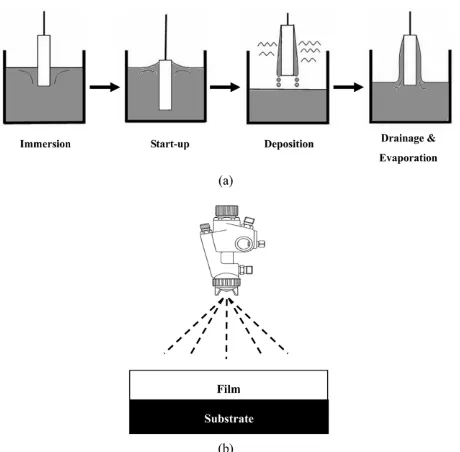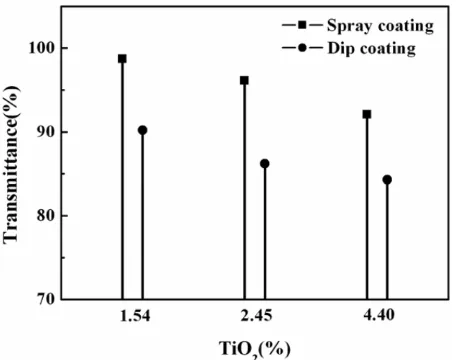219
A great deal of attention has been drawn to the coating of transparent photocatalytic TiO2 onto outdoor building materials,
such as glass, tile and stone, for utilizing the self-cleaning effect originating from the hydrophilic behavior of the coated layer under ultraviolet irradiation. Two key technologies should be developed for the successful commercialization of a hydrophilic photocatalyst, i.e., superior activity of the TiO2 sol, and a transparent and strong adhesive coating. A photocatalytic TiO2 sol
showing a high degree of hydrophilicity was prepared by a sol-gel technique using titanium (IV) isoproxide as a starting materials. The concentration of TiO2 was controlled by varying the amount of water and ethanol. The sol was coated on the
glass substrate by either a spray or dip coating technique. The characteristics of the coated layer were evaluated in terms of wetting angle, transparency and adhesion strength under the conditions of ultraviolet irradiation. The wettability of a water drop for the wetting angle, UV-visible spectrometer for transparency and pencil hardness for adhesive strength were employed for the evaluations. The coated TiO2 layer using 1.54 wt% TiO2 sol showed more than 95% transparency, less than 10o of
wetting angel and an adhesive strength of 7H. As a result of this study, photocatalytic TiO2 coated stone for the application
of outdoor building materials has been successfully commercialized. Key words: Photocatalytic TiO2 sol, Hydrophilicity, Coating, Transparency.
Introduction
Depletion of fossil fuel energy resources together with environmental contamination has long been a crucial global issue depending on the degree of industrialization. Research on photocatalysts showed the decomposition of organic contaminant using clean solar energy without yielding any harmful by-products [1, 2]. In particular, photocatalytic TiO2 exhibited higher activities in oxidation and reduction
processes and stability to chemical reactions in comparison with SiO2, ZnO, WO3, CdS while maintaining a relatively
low cost [3, 4]. Although the slurry of photocatalytic TiO2
particles was extensively studied earlier, the problems of recycling power and blocking of stimulus light due to dispersed particles caused the development of techniques for fixing the photocatalyst on the substrate. Furthermore, a transparent coating layer of photocatalytic TiO2 on the
substrate was required to have same color and texture after coating as the support had originally revealed. Coating of an adhesive and transparent photocatalytic TiO2 layer could
be achieved by combining the preparation of a transparent sol with a proper concentration of nano-crystalline TiO2 and
relevant coating technology. The coated thin TiO2 layer
would show the self-cleaning effect due to the hydrophilicity
which reduces the wetting angle of water to less than 10o
under the conditions of ultraviolet irradiation. Water with a low wetting angle can penetrate between the contaminant and substrate, and cleans the surface from rainfall [5] This self-cleaning effect of the transparent photocatalytic layer could be extensively applied to various lamps, anti-fogging mirrors, window glass and car bodies etc [3].
Photocatalytic TiO2 samples were conventionally
fabricated by one of several methods. i.e., precipitation, hydrothermal and sol-gel. The hydrothermal technique was used for a powder form of TiO2 and required complex
equipment and had the disadvantage of discontinuous processing, whereas the precipitation technique allowed relatively easy fabrication but resulted in an inhomogeneous composition and agglomerations [6, 7]. On the other hand, the sol-gel process can produce a high purity and homogeneous sol at low temperature using simple equipment for a coating layer [8].
An aim of this study was to establish the techniques of (a) forming a transparent TiO2 sol using a conventional
sol-gel method and (b) coating this sol on to a glass substrate for the self-cleaning effect.
Experimental
Synthesis of TiO
2sol
Amongst the metallic compounds such as metal alkoxides, carboxylate and metal inorganic complexes, the metal
alkoxide precursor, titanium isopropoxide (TTIP; 98% Junsei Chemical Co., LTD., Japan, Ti[OCH(CH3)2]4), was
selected due to its higher reativity. Although TTIP exhibited the advantage of forming crytalline TiO2 at a relatively low
temperature, but a high reactivity caused fast hydrolysis with even a little moisture in the air. Thus, the hydrolysis was performed in a N2 atmosphere. A schematic of the
experimental set-up is presented in Fig. 1. Distilled water in the range of 30 to 100 M was added to the precursor for hydration while adding HCl with a pH of 1 to generate the electol-static attractive force which resulted in a stable and homogeneous solution by preventing sedimentation and agglomeration due to the fast hydration and subsequent condensation process [9] The mixture of precursor, water and acid was stirred for 2 hours at 80oC in order
to reduce the reaction time required for the formation of the sol, and the temperature for generating the anatase type crystalline TiO2. The mixture was heated for 30minutes
to evaporate the acid, then ethanol was added as a solvent which would contribute to the rapid drying after coating and transparency of the coated layer. The processing of the TiO2 sol is shown in Fig. 2, and the concentrations
of TiO2 in various sols are summarized in Table 1.
Coating of TiO
2thin film
Conventional soda lime glass (25×75 mm) slides were prepared as substrates after ultrasonic cleaning for 30minutes to remove any contaminant on the surface. Dip and spray coating were performed as shown in Fig. 3. The equipment for dip coating (KEE-PAE Trading Co., Model KPD-101) was used for dipping the glass sample in to the sol with a speed of 300 mm/minutes and holding time of 30 seconds in the sol and then pulled out with the same speed. Spray
coating was also performed using the equipment shown in Fig. 3. The sol was sprayed through the nozzle with an the air pressure of 288 MPa. The moving speed of spray nozzle above the glass sample and the amount of sol while spraying were controlled automatically by a computer. Coating was carried out only one time, and dried for 2 hours at ambient temperature prior to subsequent drying for 1 hour at 60oC
Characterization of TiO
2sol and TiO
2thin films
DSC/TG (TA, Model SDT Q600) and XRD (RIGADU Model D/Max-3c) techniques were used to analyze the crystallization behaviour of the TiO2 sol and the type of
crystalline phase formed, respectively. The precursor
Fig. 1. Experimental set-up for preparation of TiO2 sol via sol-gel
process using titanium (IV) isopropoxide as the raw starting material. The sol was heat-treated for 2hours yielding anatase crystallites.
Fig. 2.Flow chart for manufacturing the coating solution using
titanium (IV) isopropoxide.
Table 1. Concentration of TiO2 sol depending on H2O. One
mole of TTIP, 100 mole of ethyl alcohol and HCl for pH≈1 were
fixed except mole number of H2O.
H2O TiO2(%)
120M 1.54
060M 2.43
030M 4.40
was reacted with water, and then the slurry was dried below 70oC to obtain precursor powder. The TiO
2 sol was
also dried at room temperature before subsequent drying below 70oC to obtain the powder. Both powders were
used for the analysis. The hydrophilicity of the coated layer was evaluated by measuring the wetting angle of a water drop using the equipment (SEO, Model SEO 300A, Korea) while irradiating with the ultraviolet light generated by a lamp of 25W UV-A.. In addition, the tranparancy of the coated layer was measured by a UV-visible spectrophotometer (SCINCO Co., Model s-3100). The thickness and surface morphology of the coated layer depending on the coating method were examined by FE-SEM(Jeol Co., Model JSM-6400).
Results and Discussion
Characteristics of photocatalytic TiO
2sol
The occurrence of anatase crystallites was examined using DSC/TG together with XRD analysis for the powder
prepared from the sol fabricated by stirring at 80oC for
2 hours showing Fig. 4. For the TTIP precursor, a weight loss at around 100oC due to the evaporation of water was
observed in the TGA curve, and an endothermic peak due to water evaporation at around 100oC and exothermic
peak at around 400oC in the DSC curve which would
be attributed to the crystallization are observed as shown in Fig. 4(a). A weight loss at around 100oC for the powder
obtained from the sol and the exothermic peak due to the ignition of C-H organics are observed in Fig. 4(b) However, the exothermic peak presumed to originate from crystallization was not observed at around 400oC. The
powder obtained from the sol which was reacted at 80oC
exhibited the anatase crystalline structure as shown in Fig. 5. This implies that the sol prepared at 80oC contains
anatase crystallites although the TTIP precursor needs to be heat treated at a temperature as high as 400oC for
crystallization. Thus coating at room temperature using the sol can show photocatalytic activity without further
Fig. 3.A schematic of coating methods (a) dip coating, (b) spray
coating.
Fig. 4.DSC/TG curves of the (a) precursor, (b) TiO2 sol.
Fig. 5.X-ray diffraction patterns of the (a)TiO2 sol, (b)precursor.
Fig. 6.Variation of contact angles depending on coating method
and TiO2 concentration. The spray coated layer showed thinner
2μm thickness compared to 4μm of dip coated layer, and high
heat treatment at a higher temperature after coating. This can certainly widen the applicability of the sol to various substrate materials.
Characteristics of coated layer
The hydropilicity of the coated layer was evaluated by measuring the wetting angle of a water drop on the surface. The contact angles both left and right hand sides of a water drop were averaged. Various contact angles depending on the coating method, i.e., spray or dip coating, and the concentration of TiO2 in the sol were compared as
shown in Fig 6. A wetting angle below 10o was observed
irrespective of the coating method, however the angle on the surface of the dip coated layer exhibited a smaller angle that on the spray coated layer. Also the angle decreased with an increase in the TiO2 concentration.
Many attempts of coating using commercially available photocatalytic TiO2 solutions have consistently produced
opaque layers, and could not reveal the original color of the substrate. Thus, a transparent coating layer formed at room temperature should be developed for the wider applications of photocatalytic TiO2. The transparency
of visible light depending on the coating method and TiO2 concentration was measured using a UV-visible
spectrophotometer and showing Fig.7. The dip coated layer showed about 10% lower transparency in comparison
with the spray coated one, which in attributed to the thickness of layer. However, both coating techniques yielded a transparency of higher than 85%.
The thickness of the coated layer depending on the coating method was examined by SEM and showing Fig. 8. About 4μm coated layer was formed by dip coating
whereas about 2μm thickness was observed in the spray
coated layer. Accordingly, the lower transparency of the dip coated sample could be explained by the thicker coating layer. The surface morphology of the spray coated sample Fig. 8(c) showed closely packed spherical TiO2 particles
several tens of nm in size.
The adhesion between the coating layer and substrate was measured by a pencil hardness tester. The dip coated layer showed 7H pencil hardness which is significantly higher than the 4H of the commercially available TiO2
solution coated by the same dip coating technique.
Conclusions
1. A photocatalytic TiO2 sol containing anatase crystallites
was fabricated through a conventional sol-gel process using a titanium isopropoxide precursor.
2. A coating with a 1.54% sol TiO2 on the soda lime
glass by a spray coating technique showed a high hydrophilicity (~7o wetting angle) and better than
95% transparency for visible light.
Fig. 7.Variation of transmittance 380-770 nm depending on the
coating method and the TiO2 concentration spray coated layer of 2μm
thickness showed better transmittance.
Fig. 9.Adhesion strength of TiO2 thin film tested by a pencil
hardness tester: (a) spray coating, (b) dip coating, dip coated layer showed stronger adhesion.
Research Institute of Gyeongsang National University.


